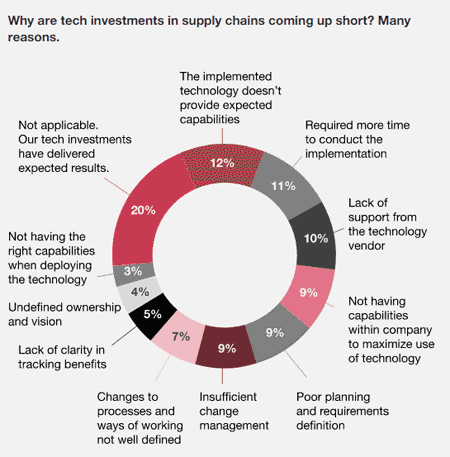Why don't Supply Chain Technology Projects Deliver?
A couple of weeks ago, SCDigest summarized a new study from PwC, nominally on supply chain digitization. (See Digitizing Supply Chains Proving to be Slow Go.)
As the headline for the story indicates, the theme of the survey and resulting study was that despite the strong professed interest by executives in digitizing their supply chains, the pace of digitization is slow, for a variety of reasons.
| GILMORE SAYS: |
WHAT DO YOU SAY?'
Some of the factors, such as knowing what capabilities and even change management (with the right investment) are fairly easily addressed. Others, such as lack of vendor support, are tougher.
Send us your
Feedback here
|
One of those reasons is that supply chain technology is not delivering expected results. Not by a little - by a lot, at least according to the survey.
Rather stunningly, in fact, the survey - based on responses from 244 operations and information technology leaders, C-suite executives and other supply chain officers - found that just 20% of companies are viewing supply chain technology projects as well meeting expectations.
If accurate, that is a rather extraordinary state of affairs. Can it possibly be that 80% of supply chain technology projects are delivering unsatisfactory results?
I would certainly have guessed a much higher percentage of success, maybe in the 50% range - half well-deliver results, half don't. Even that would be a disappointing result, but not nearly as worrisome of a track record of just a 20% success rate.
A couple of thoughts. First, the survey results may not be valid. Just as one easy example, from my difficult course in statistics in grad school, perhaps the survey population was somehow overly comprised of those disgruntled with technology. Or, a group of 244 respondents may not be enough to be statistically valid for the overall population.
But perhaps the result is largely accurate. What on earth is causing 80% of supply chain technology projects to be viewed as not fully delivering expected results?
One thing that occurred to me is that the execs who provided the survey results may simply define success differently than middle management. Maybe even a technology project that meets most local objectives doesn't really move the corporate needle from an executive view, and thus was not seen as a success.
But PwC in fact asked respondents the key factor they would cite in why supply technology projects go astray. The results are very interesting.
As seen below in the graphic from the report, 10 factors were cited. It is not clear if these factors were presented for the respondents to select from, or if they were unprompted. I would think the former.

Source: PwC
The top factor cited was that the technology simply did not provide the expected capabilities. Though it was the number 1 factor, it only garnered 12% of the vote (including the 20% that were satisfied). If we remove that 20%, this factor jumps from 12% of all respondents to 15% of those who weren't satisfied.
So riddle me this: how is it that supply chain technology - I am assuming mostly meaning software - can be evaluated, selected and deployed - only to find it doesn't actually have the capabilities the company was expecting?
What gives? The company was bamboozled by the technology vendor? There was some level of incompetence (happy for a less negative word) that the company couldn't really figure out what they were actualy buying?
There is one potential reason I have cited before under different circumstances, and it is this: In software evaluation, companies often spread their attention too broadly, and spend too much time evaluating, for example in software demos, commodity capabilities that won't add much value to the company. As a result, those capabilities that are critical to realizing the desired business results - maybe 6 to 12 - do not get sufficient attention.
And thus capabilities that are expected are really not there.
All the rest of the factors cited also ring true. Longer than expected time to implement, which came in a number 2? Happens all the time, for a variety of reasons. Among the group of three factors tied for third place (each cited by 9% of respondents), lack of effective change management is very common, and probably should have a higher percentage.
Lack of capabilities (and I would add "or resources") to take advantage of the technology also resonates.
My bottom line: I believe the percent of supply chain technology projects that are deemed as largely successful is higher than the 20% found in this study. Just how much more I am not sure. But the succes rate is also often technology vendor-specific.
Some of the factors, such as knowing what capabilities and even change management (with the right investment) are fairly easily addressed. Others, such as lack of vendor support, are tougher.
In the end, I think the best use of this list of non-success factors is to use it as a guide for a plan on how you are going to mitigate the risk of every single one of them - so that your batting average on technology can be much higher than the rest of the league.
What do you think the supply chain technology success rate is? What factors do you see as most common? Let us know your thoughts at the Feedback button (email) or section below.
|












